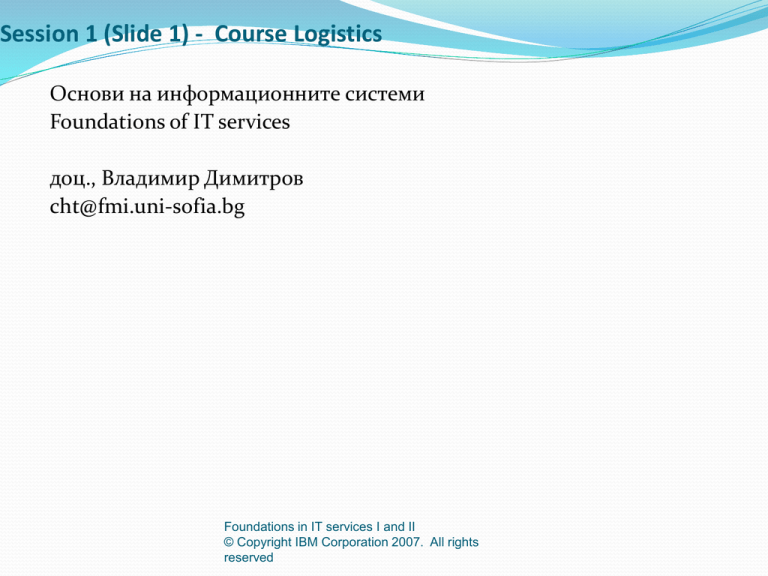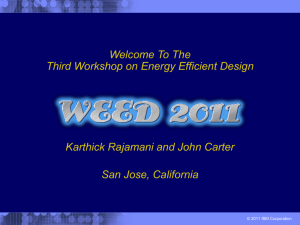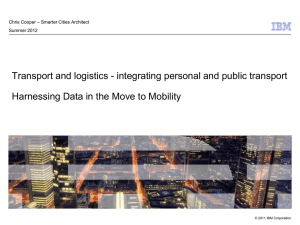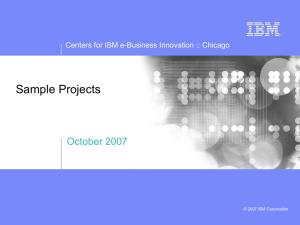
Session 1 (Slide 1) - Course Logistics
Основи на информационните системи
Foundations of IT services
доц., Владимир Димитров
cht@fmi.uni-sofia.bg
Foundations in IT services I and II
© Copyright IBM Corporation 2007. All rights
reserved
Authors acknowledgement and modification, terms of use and copyright and
trademark information
Initial compilation and authoring: David Graves and Paul
Kontogiorgis
Initial compilation and author date: 08/21/06. Additional
modifications and dates are included in the lecture notes.
By using these materials you agree to the IBM Terms of Use:
http://www.ibm.com/legal/us/.
The IBM copyright and trademark information webpage is
incorporated herein by reference:
http://www.ibm.com/legal/copytrade.shtml.
Foundations in IT services I and II
© Copyright IBM Corporation 2007. All rights
reserved
Session 1 (Slide 2) - Course Overview
Session 1 - Course Logistics - Course Overview - Questionnaire
Session 2 - Computing Infrastructure Overview Computing
Platforms and OS
Session 3 - Computing Infrastructure Overview – Networks
Session 4 - Computing Infrastructure Overview – Storage
Session 5 - Computing Infrastructure Overview - Applications
(DB, Middleware, CRM, IT Management, etc)
Session 6 - Introduction to IT Services - ESM Introduction (IT
Service Management)
Session 7 - ESM Introduction (IT Infrastructure Management)
Session 8 – Exam
Session 9 - Event & Fault Management (Introduction of terms and
concepts)
Foundations in IT services I and II
© Copyright IBM Corporation 2007. All rights
reserved
Session 1 (Slide 2) - Course Overview
Session 10 - Event Management Cont. (Implementation and
Configuration of Event Mgmt Service)
Session 11 - Event Management Cont. (Event Processing Operations Management (Notification, Escalation, etc))
Session 12 - Event Management Cont. (Service Interconnections
and Tools Sampling)
Session 13 - Problem Management
Session 14 - Change Management
Session 15 - Exam
Session 16 - Configuration Management
Session 17 - Asset Management (Inventory)
Session 18 - Asset Management (Software Distribution)
Foundations in IT services I and II
© Copyright IBM Corporation 2007. All rights
reserved
Session 1 (Slide 2) - Course Overview
Session 19 - Performance and Capacity Management
Session 20 - Midterm Exam
Session 21- Case Study Overview and Assignments
Session 22 - Security Management
Session 23 - Network Management
Session 24 - Case Study Workshop (Tools Survey/Research)
Session 25 - Storage Management
Session 26 - Workload Management
Session 27 - Backup and Recovery Management
Session 28 - Exam
Session 29 - Case Study Workshop (Customer Feedback)
Session 30 - End User Services (End User Self-Enablement,
Remote Control, Help Desk, Deskside Support, Client Image
Services)
Foundations in IT services I and II
© Copyright IBM Corporation 2007. All rights
reserved
Session 1 (Slide 2) - Course Overview
Session 31 - Reporting Management
Session 32 - Business Process Management Fundamentals Overview
Session 33 - Business Process Management Supporting
Infrastructure
Session 34 - Case Study Extension
Session 35 - Case Study Presentations
Session 36 - Case Study Presentations
Sessions 37-39 - Final Exam
Foundations in IT services I and II
© Copyright IBM Corporation 2007. All rights
reserved
Session 1 (Slide 3) - Questionnaire
1.
2.
3.
4.
5.
6.
7.
8.
Какъв опит имате с компютрите (операционни системи, езици за
програмиране, приложения)?
Какви курсове по информатика сте взели до сега и кога (не само от
учебната програма по Информационни системи)?
Какво очаквате да научите в този курс (вашите очаквания)?
Работите ли някъде, къде и какво?
Какви са вашите интереси в информатиката – в кои области?
Работили ли сте в някоя по-специализирана област на приложение
на компютрите (напр. помощ за клиентите, мрежи)?
С какви компютърни системи и къде имате достъп?
С какво мислите, че ще ви помогне този курс?
Foundations in IT services I and II
© Copyright IBM Corporation 2007. All rights
reserved
Session 2 (Slide 1) - Computing Infrastructure Overview
Computing Platforms and OS
Platform can be viewed as a framework, either in hardware or software, allowing
software to run.
Framework is a defined support structure in which another project can be
developed
The most common platforms include a computer's architecture, operating
system, or programming languages
Foundations in IT services I and II
© Copyright IBM Corporation 2007. All rights
reserved
Session 2 (Slide 2) - Computing Infrastructure Overview
Computing Platforms and OS
PC (Personal Computer)
Laptop
Server
Midrange
Mainframe
Supercomputers
Foundations in IT services I and II
© Copyright IBM Corporation 2007. All rights
reserved
Session 2 (Slide 3)- Computing Infrastructure Overview
Computing Platforms and OS
Operating system (OS) is a type of software which manages the hardware and
software resources of a computer.
OS tasks include controlling and allocating memory, prioritizing the processing
of instructions, controlling input and output devices, facilitating networking,
and managing files.
The kernel is the lowest level of any operating system
Most operating systems contain system software that manages a graphical user
interface (Windows). Others use CLI, or command line interface (Unix)
Foundations in IT services I and II
© Copyright IBM Corporation 2007. All rights
reserved
Session 2 (Slide 4) - Computing Infrastructure Overview
Computing Platforms and OS
Examples of Operating Systems include:
Microsoft Windows
UNIX
Linux
Macintosh OS
Linux (GNU/Linux)
Foundations in IT services I and II
© Copyright IBM Corporation 2007. All rights
reserved
Session 3 (Slide 1) - Computing Infrastructure Overview
Networks
Computer networking is considered a multidisciplinary field combining science
and engineering to provide communication between computer systems.
Networks involves two or more computers, which can be separated by a few
centimeters (for example Bluetooth) or thousands of kilometers through the
Internet.
Computer networking is also considered a sub-discipline of
telecommunications.
Foundations in IT services I and II
© Copyright IBM Corporation 2007. All rights
reserved
Session 3 (Slide 2) - Computing Infrastructure Overview
Networks
Computer networks are implemented using protocol stack architectures,
computer buses, or combinations of layers (media and protocol)
The OSI modelTCP/IP model defines the Network access layer as:
Transport layer
Network layer
Data link layer
Physical layer
Foundations in IT services I and II
© Copyright IBM Corporation 2007. All rights
reserved
Session 3 (Slide 3) - Computing Infrastructure Overview
Networks
A network topology is the pattern of links connecting nodes of a network.
One-way links are the simplest connection between two devices. Return links or
secondary links may be added for two-way communication.
Examples of network topologies include ring, mesh, star, fully connected, line,
tree and bus.
Foundations in IT services I and II
© Copyright IBM Corporation 2007. All rights
reserved
Session 3 (Slide 4) - Computing Infrastructure Overview
Networks
Important Networking concepts include:
Hubs
Routers
Printers
Firewalls
Switches
Fiber Optic panels
Storage area networks
Server network interfaces
Other Local Area Network (LAN) components
Wide Area Network (WAN) circuits
Metropolitan Area Network (MAN) circuits
Foundations in IT services I and II
© Copyright IBM Corporation 2007. All rights
reserved
Session 4 (Slide 1)- Computing Infrastructure Overview
Storage
The term “computer storage” broadly refers to integrated circuits, magnetic or
optical disks, and/or cartridge tape devices used by computer systems to record
and retain digital data for some interval of time.
Storage more commonly referred to as mass storage – magnetic disks, removable
optical disks, tape cartridges, and other types of media is:
Much slower than RAM (Random Access Memory)
Far less expensive than RAM
Designed for permanent retention of data
Foundations in IT services I and II
© Copyright IBM Corporation 2007. All rights
reserved
Session 4 (Slide 2) - Computing Infrastructure Overview
Storage
Characterization of storage includes a tiered hierarchy, or the division of
primary, secondary, tertiary and off-line storage or distance from the central
processing unit.
Other ways to characterize various types of storage includes:
Volatility of Information
Ability to access non-contiguous information
Ability to change information
Addressability of information
Capacity and Performance
Stability of media over time
Foundations in IT services I and II
© Copyright IBM Corporation 2007. All rights
reserved
Session 4 (Slide 3) - Computing Infrastructure Overview
Storage
Foundations in IT services I and II
© Copyright IBM Corporation 2007. All rights reserved
Session 4 (Slide 4) - Computing Infrastructure Overview
Storage
Primary storage, or internal memory, is computer memory that is accessible to
the central processing unit of a computer via a high performance memory bus
and without the use of computer's input/output channels.
Primary storage is used to store data that is likely to be in active use also called a
“ready reference” site to hold both data and binary code that is in active use.
Primary storage is significantly more expensive than other types of storage
media
Primary storage may be built from dynamic (RAM) or fixed (ROM) memory, or
some combination thereof
Foundations in IT services I and II
© Copyright IBM Corporation 2007. All rights
reserved
Session 4 (Slide 5) - Computing Infrastructure Overview
Storage
Primary Storage Cont. – RAM
RAM (Random Access Memory) is:
Temporary storage; frequently modifying and/or replacing its stored
contents
Extremely fast, when compared to other types of storage
Expensive, when compared to other types of storage
Volatile, losing retained information if the power is interrupted
Dynamic cells (must be constantly electrically refreshed to retain contents)
DRAM
SDRAM
VRAM
RDAM
Static cells (content is retained as long as power is applied to the bus) include
SRAM and Cache
Foundations in IT services I and II
© Copyright IBM Corporation 2007. All rights
reserved
Session 4 (Slide 6) - Computing Infrastructure Overview
Storage
Primary Storage Cont. ROM –
ROM (Read Only Memory) memory is:
Fixed content; commonly used for data or code that does not change
(example: system bios)
Extremely fast, when compared to other types of storage
Expensive, when compared to other types of storage
Non-volatile, retaining cell content regardless of whether power is applied
to the bus or not
Examples of ROM include:
ROM (fixed content read-only memory)
PROM (programmable read-only memory)
EPROM (electrically re-programmable read-only memory; contents are
erasable under ultraviolet light)
EEPROM (electrically erasable/electrically re-programmable read-only
memory)
in IT services I and II
Flash memory (aFoundations
board-resident
form of EEPROM)
© Copyright IBM Corporation 2007. All rights
reserved
Session 4 (Slide 7) - Computing Infrastructure Overview
Storage
Secondary storage, also called external memory, is memory that is not directly
attached to the central processing unit of a computer, requiring the use of
computer's input/output channels.
Secondary storage is used to maintain data that is not in active use. It is
significantly slower than primary storage but has much greater storage capacity
and is non-volatile, preserving stored data in an event of power loss.
Storage devices in this category include:
Hard disk (magnetic or optical)
Floppy disk
CD, CD-R, CD-RW
DVD
Magnetic tape
Paper tape and punch cards
External RAMdisk subsystems
Foundations in IT services I and II
© Copyright IBM Corporation 2007. All rights
reserved
Session 4 (Slide 8) - Computing Infrastructure Overview
Storage
Secondary Storage – cont.
Network storage is any type of computer storage that involves accessing
information over a computer network.
SAN
NAS
Examples of Network storage includes:
Network-attached storage is secondary or tertiary storage attached to a
computer which another computer can access over a local-area network, a
private wide-area network, or in the case of online file storage, over the
Internet.
Network computers are computers that do not contain internal secondary
storage devices. Instead, documents and other data are stored on a
network-attached storage.
Foundations in IT services I and II
© Copyright IBM Corporation 2007. All rights
reserved
Session 4 (Slide 9) - Computing Infrastructure Overview
Storage
Tertiary storage or tertiary memory, is a computer storage system consisting of
one or more storage drives and an automatic media library, for example a tape
library or optical disc jukebox.
Near-line storage is a storage medium that can be recalled without manual
intervention, but usually at the cost of incurring a significant delay. (i.e. – direct
data retrieval from a tape library or optical jukebox.
Off-line storage is a computer storage medium which must be inserted into a
storage drive by a human operator before a computer can access the information
stored on the medium.
Examples of Off-line storage include floppy disks, optical discs, and magnetic
tape.
Foundations in IT services I and II
© Copyright IBM Corporation 2007. All rights
reserved
Session 5 (Slide 1) - Computing Infrastructure Overview
Applications (DB, Middleware, CRM, IT Management, etc.)
Computer software are the programs and procedures that provide a computer
the ability to perform a task.
There are three major software classes:
System software runs the computer hardware and the computer system.
Programming software provides tools for writing computer programs and
software using different programming languages
Application software
Foundations in IT services I and II
© Copyright IBM Corporation 2007. All rights
reserved
Session 5 (Slide 2) - Computing Infrastructure Overview
Applications (DB, Middleware, CRM, IT Management, etc.)
Application software is a subclass of computer software that calls on the
computer directly to perform a task
Application software allows users to accomplish non-computer related tasks.
Note: Application refers to both the application software and its implementation.
Businesses are the biggest users of application software
Many application software examples may be found at the Business Software
Directory.
Foundations in IT services I and II
© Copyright IBM Corporation 2007. All rights
reserved
Session 5 (Slide 3) - Computing Infrastructure Overview
Applications (DB, Middleware, CRM, IT Management, etc.)
Application software classification includes:
Analytical software
Statistical packages
Collaborative software
Blogs, Wiki’s
Computer-mediated communication
E-mail, Web Browsers
Business software
CRM, enterprise business software, etc
Database Software
Oracle, DB2, Microsoft SQL, Informix
Entertainment and Multimedia and Art Software
Video games, picture
editing
sw, I and II
Foundations
in IT services
© Copyright IBM Corporation 2007. All rights
reserved
Session 5 (Slide 4) - Computing Infrastructure Overview
Applications (DB, Middleware, CRM, IT Management, etc.)
Application software classification includes:
Middleware software
Message Queue Series, Tuxedo
IT Management software
Tivoli, CA Unicenter, HP Openview, etc.
Foundations in IT services I and II
© Copyright IBM Corporation 2007. All rights
reserved
Session 6 (Slide 1) - Introduction to IT Services –
ESM Introduction
Enterprise – an entire company, everything, all-inclusive
Systems – Information Technology Infrastructure, hardware and software, data,
information, and processes
Management – The monitoring and controlling of entities
Service – Providing function to something or someone
Business Process or Process – The method used to perform tasks or jobs
Foundations in IT services I and II
© Copyright IBM Corporation 2007. All rights
reserved
Session 6 (Slide 2) - Introduction to IT Services –
ESM Introduction - Definitions
Enterprise Systems Management - The complete and total management of a
company's IT elements and/or environment
Enterprise Operational Process - The foundation and creation point for all
management related services for the enterprise
Server OS - The operating system is responsible for running and managing the
server. Some examples include Windows, Linux, Unix, etc
Application - A program run on a computer to satisfy a certain need under the
OS (examples include Lotus Notes, Siebel, WebSphere)
Network - The layer of computing the is responsible for interconnecting IT
elements
Database - An application primarily used for storing data
Foundations in IT services I and II
© Copyright IBM Corporation 2007. All rights
reserved
Session 6 (Slide 3) - Introduction to IT Services –
ESM Introduction - Definitions
Process Layer - The layer in ESM containing the Operational Processes
Functional Layer - The layer in ESM containing the management disciplines for
services
I/T Element Layer - The layer in ESM enumerating the I/T elements in the
environment
Infrastructure Management - The discipline regarding services responsible for
maintaining and managing the IT elements in an environment
Relationship Management - The discipline containing the services that are
customer facing in relation to their IT infrastructure
Foundations in IT services I and II
© Copyright IBM Corporation 2007. All rights
reserved
Session 6 (Slide 4) - Introduction to IT Services –
ESM Introduction - Definitions
Inter-Discipline Interface - Connection between two management disciplines
Inter-Service Interface - Connection between two services
Foundations in IT services I and II
© Copyright IBM Corporation 2007. All rights
reserved
Session 6 (Slide 5) - Introduction to IT Services –
ESM Introduction – Services Definitions
Customer Service Center - The location where customer interact and interface
with the IT provider
Command Center - The location where operators manage the IT environment
Subject Matter Experts (SME's) - Personnel trained in specific areas within the
IT environment, such as application, network, os, etc
Project Office - The group within the IT provider matrix responsible for
managing the revolving projects for a customer
Composite Elements - Disparate data collected to manage the IT infrastructure
Server/Application Elements - IT elements directly supporting the hw, os, and
applications within the IT infrastructure
Network Elements - IT elements directly supporting the interconnections
within the IT infrastructure
Foundations in IT services I and II
© Copyright IBM Corporation 2007. All rights
reserved
Session 6 (Slide 6) - Introduction to IT Services –
ESM Introduction – Services Definitions
Capacity/Performance Management - The non-functional service regarding the
long term trending of performance coupled with a knowledge of future load to
predict needed capacity
Operations Management - The service responsible for directly managing the IT
infrastructure based on user experience and event management outputs
Recovery Management - The service which manages the complete recovery of
your IT infrastructure which is closely related to backup management
Security Management - The service managing the protection of your IT
infrastructure from external attacks, and preventative measures taken to meet
the same
Business Process Management - The service mapping IT elements to a
customer's major business processes
Remote Control - The service managing IT elements remotely, usually through
an agent to reduce downtime
Foundations in IT services I and II
© Copyright IBM Corporation 2007. All rights
reserved
Session 6 (Slide 7) - Introduction to IT Services –
ESM Introduction – Services Definitions
Inventory - The service responsible for capturing the software and hardware
information for a customer's IT environment
Reporting Management - The service responsible for collecting and displaying
data to the infrastructure owners and customers
Request Management - The service responsible for retaining collecting and
managing requests made of the IT environment
Foundations in IT services I and II
© Copyright IBM Corporation 2007. All rights
reserved
Session 6 (Slide 8) - Introduction to IT Services –
ESM Introduction – Services Definitions
SLA Management - The service, which is closely tied into reporting
management, responsible for capturing and displaying Service Level Agreement
data
Knowledge Management - The service containing reusable standardized
information used for reference and future engagements
Asset Management - The service is the combination of Remote Control,
Inventory and Software Distribution services
Notification/Escalation Management - The service responsible for managing
the appropriate notification based on event management outputs
Foundations in IT services I and II
© Copyright IBM Corporation 2007. All rights
reserved
Session 6 (Slide 9) - Introduction to IT Services –
ESM Introduction – Services Definitions
Call/Problem Management - The service responsible for managing user
deficiencies and alerting the appropriate parties
Change Management - The service managing the requests and completion of
changes made to the IT infrastructure
End-User Experience Management - The service managing the non-functional
(intangible qualities such as performance) customer requirements
Platform Management Systems - Systems within the IT infrastructure that
manage the server and application IT elements
SNMP Management - The service responsible for managing SNMP (Simple
Network Management Protocol) traffic
Foundations in IT services I and II
© Copyright IBM Corporation 2007. All rights
reserved
Session 6 (Slide 10) - Introduction to IT Services –
ESM Introduction (IT Service Management)
IT Service Management or Relationship Management - The discipline
containing the services that are customer facing in relation to their IT
infrastructure
Reporting
Request management
Service level agreement management
Knowledge management
Asset management
Notification
Escalation
Help desk
Problem management
Change management
Foundations in IT services I and II
© Copyright IBM Corporation 2007. All rights
reserved
Session 7 (Slide 1) - Introduction to IT Services –
ESM Introduction (IT Infrastructure Management)
Infrastructure Management - The discipline regarding services responsible for
maintaining and managing the IT elements in an environment
Infrastructure Management
Backup
Recovery
Software distribution
Configuration
Event
Availability
Capacity
Performance
Foundations in IT services I and II
© Copyright IBM Corporation 2007. All rights
reserved
Session 7 (Slide 2) - Introduction to IT Services –
ESM Introduction (IT Infrastructure Management)
Infrastructure Management
Operations
Disaster recovery
Security
Remote control
Inventory
Provisioning
Storage
License
Business process
Foundations in IT services I and II
© Copyright IBM Corporation 2007. All rights
reserved
Session 7 (Slide 3) - Introduction to IT Services –
ESM Introduction (IT Infrastructure Management)
Infrastructure Management
Relationship Management
Software Distribution
Configuration Management
Configuration Management
Reporting
Event Management
Availability Management
Capacity / Performance
Operations Management
Recovery Management
Security Management
Business Process Mgt.
Remote Control
Inventory
Command Center,
Subject Matter Experts
Foundations in IT services I and II
© Copyright IBM Corporation 2007. All rights reserved
Request Management
SLA Management
Knowledge Management
Asset Management
Notification / Escalation
Call / Problem Management
Change Management
Customer Service Center,
Project Office,
Web Portal
Indicates Service or Discipline Interface
Session 7 (Slide 4) - Introduction to IT Services –
ESM Introduction (IT Infrastructure Management)
Enterprise Operational Processes
Enterprise Systems Management
Infrastructure ManagementRelationship Management
dbg420
W9X, NT, 2000, XP, Unix, Linux, OS/400, z/OS
Server
Process Layer
EV
PR
Notes, SAP, MQSeries, Exchange
Application
INV
Inter-Discipline Interface
SD
Inter-Service Interface
SNA, TCP/IP Protocols and Devices
Network
Database
DB/2, Oracle, Sybase, Lotus
Foundations in IT services I and II
© Copyright IBM Corporation 2007. All rights
End to End Management
Disciplines
and
ServicesInterface
Layer
Service
or Discipline
reservedIndicates
Functional Layer
I/T Element Layer






